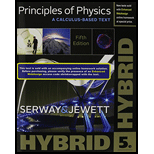
Concept explainers
(a)
The appropriate models for the system of two bullets for the time interval before to after the interval.
(a)
Answer to Problem 16P
It is an isolated system. The kinetic energy is converted into internal energy. Here, the momentum is conserved and the collision is a perfectly inelastic collision.
Explanation of Solution
Given info: The mass of one bullet is
It is an isolated system. The energy of the system is conserved but the kinetic energy is converted into internal energy. No external force exists. Here, the momentum is conserved and the collision is a perfectly inelastic collision.
Conclusion:
Therefore, it is an isolated system. The kinetic energy is converted into internal energy. Here, the momentum is conserved and the collision is a perfectly inelastic collision.
(b)
The speed of the combined bullets after the collision.
(b)
Answer to Problem 16P
The speed of the combined bullets after the collision is
Explanation of Solution
Given info: The mass of one bullet is
Write the equation for conservation of momentum.
Here,
Consider positive sign when bullet moves to the right and negative sign when bullet moves to the left.
Substitute
Conclusion:
Therefore, the speed of the combined bullets after the collision is
(c)
The amount of initial kinetic energy which is converted into internal energy of the system after the collision.
(c)
Answer to Problem 16P
The amount of initial kinetic energy which is converted into internal energy of the system after the collision is
Explanation of Solution
Given info: The mass of one bullet is
Write the equation for change in kinetic energy to calculate the amount of kinetic energy which is converted into internal energy of the system after the collision.
Substitute
Conclusion:
Therefore, the amount of initial kinetic energy which is converted into internal energy of the system after the collision is
(d)
Whether all the lead is melt due to the collision or not.
(d)
Answer to Problem 16P
No, all the lead is not melt due to the collision.
Explanation of Solution
Given info: The mass of one bullet is
Write the equation to calculate the energy Q required to change the temperature of mass m.
Here,
The specific heat of aluminum is
The melting point of lead is
Substitute
Initial energy generated by the collision is
Write the equation to calculate the amount of heat required to melt all of the lead.
Here,
L is the latent heat of the fusion for lead.
The latent heat of fusion for lead is equal to
Substitute
Here, only
Conclusion:
Therefore, all the lead is not melt due to the collision.
(e)
The temperature of the combined bullets after the collision.
(e)
Answer to Problem 16P
The temperature of the combined bullets after the collision is
Explanation of Solution
Given info: The mass of one bullet is
The available heat to melt the bullets is
The temperature of the combined bullets is the melting temperature of the bullets which is equal to
Conclusion:
Therefore, the temperature of the combined bullets after the collision is
(f)
The phase of the combined bullets after the collision.
(f)
Answer to Problem 16P
The phase of the combined bullets after the collision is such that
Explanation of Solution
Given info: The mass of one bullet is
Write the equation to calculate the total melted mass of lead.
Substitute
Calculate the mass of solid lead.
Substitute
Conclusion:
Therefore, the phase of the combined bullets after the collision is such that
Want to see more full solutions like this?
Chapter 17 Solutions
Principles of Physics: A Calculus-Based Text, Hybrid (with Enhanced WebAssign Printed Access Card)
- An object is placed 24.1 cm to the left of a diverging lens (f = -6.51 cm). A concave mirror (f= 14.8 cm) is placed 30.2 cm to the right of the lens to form an image of the first image formed by the lens. Find the final image distance, measured relative to the mirror. (b) Is the final image real or virtual? (c) Is the final image upright or inverted with respect to the original object?arrow_forwardConcept Simulation 26.4 provides the option of exploring the ray diagram that applies to this problem. The distance between an object and its image formed by a diverging lens is 5.90 cm. The focal length of the lens is -2.60 cm. Find (a) the image distance and (b) the object distance.arrow_forwardPls help ASAParrow_forward
 Principles of Physics: A Calculus-Based TextPhysicsISBN:9781133104261Author:Raymond A. Serway, John W. JewettPublisher:Cengage Learning
Principles of Physics: A Calculus-Based TextPhysicsISBN:9781133104261Author:Raymond A. Serway, John W. JewettPublisher:Cengage Learning Physics for Scientists and EngineersPhysicsISBN:9781337553278Author:Raymond A. Serway, John W. JewettPublisher:Cengage Learning
Physics for Scientists and EngineersPhysicsISBN:9781337553278Author:Raymond A. Serway, John W. JewettPublisher:Cengage Learning Physics for Scientists and Engineers with Modern ...PhysicsISBN:9781337553292Author:Raymond A. Serway, John W. JewettPublisher:Cengage Learning
Physics for Scientists and Engineers with Modern ...PhysicsISBN:9781337553292Author:Raymond A. Serway, John W. JewettPublisher:Cengage Learning College PhysicsPhysicsISBN:9781938168000Author:Paul Peter Urone, Roger HinrichsPublisher:OpenStax College
College PhysicsPhysicsISBN:9781938168000Author:Paul Peter Urone, Roger HinrichsPublisher:OpenStax College Physics for Scientists and Engineers, Technology ...PhysicsISBN:9781305116399Author:Raymond A. Serway, John W. JewettPublisher:Cengage Learning
Physics for Scientists and Engineers, Technology ...PhysicsISBN:9781305116399Author:Raymond A. Serway, John W. JewettPublisher:Cengage Learning Physics for Scientists and Engineers: Foundations...PhysicsISBN:9781133939146Author:Katz, Debora M.Publisher:Cengage Learning
Physics for Scientists and Engineers: Foundations...PhysicsISBN:9781133939146Author:Katz, Debora M.Publisher:Cengage Learning





